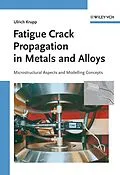This comprehensive overview of the whole field of fatigue and fracture of metallic materials covers both the theoretical background and some of the latest experimental techniques. It provides a summary of the complex interactions between material microstructure and cracks, classifying them with respect to the overall damage process with a focus on microstructurally short cracks and dynamic embrittlement. It furthermore introduces new concepts for the numerical treatment of fatigue microcrack propagation and their implementation in fatigue-life prediction models.This comprehensive overview of the whole field of fatigue and fracture of metallic materials covers both the theoretical background and the latest experimental techniques. It provides a summary of the complex interactions between material microstructure and cracks, classifying them with respect to the overall damage process. It furthermore introduces new concepts for the numerical treatment of fatigue microcrack propagation and their implementation in fatigue-life prediction models.
Autorentext
Ulrich Krupp is Senior Engineer at the Institute of Materials Technology of Siegen University, Germany, and responsible for the research files fatigue and high-temperature corrosion of metals and alloys. He completed his Ph.D. in mechanical engineering there, and also obtained his lecturing qualification (habilitation) in 2004. He spent one year at the Department of Materials Science and Engineering at the University of Pennsylvania, Philadelphia, USA, in 2002 as a Feodor Lynen fellow of the Alexander von Humboldt foundation. Hitherto, he has published over 110 scientific contributions in peer-reviewed scientific journals and conference proceedings. In 2005 his work was awarded by the Masing award of Deutsche Gesellschaft fur Materialkunde.
Klappentext
Crack initiation and early crack propagation are decisive elements of material fatigue in metallic materials, and the behavior on the microscale level in this phase greatly influences the resulting lifetime of a given material, and subsequently, its usefulness and attractiveness for specific applications. It is impossible to quantify this key phase with non-destructive testing such as ultrasonic inspection, nor are the common methods of elastic and elastic-plastic fracture mechanics applicable. Therefore, prediction possibilities and purposeful microstructure design towards improved material behavior are highly desirable. Part one of this book is a comprehensive overview on the history of fatigue and fracture research and the basic concepts of fatigue-life prediction, fracture mechanics, experimental methods, and the deformation behavior of metallic materials. The second part gives an overview on experimental studies and theoretical approaches on the interactions between the material's microstructure, the mechanical loading conditions, and the corresponding fatigue crack propagation behavior. Thirdly, the experimental results and hypotheses presented are discussed by means of phenomenological and physical models the latter being based on the numerical boundary element method. These models are intended to be applied to future mechanism-oriented life prediction of technical materials under complex service conditions.
Inhalt
Foreword vii
Preface ix
Symbols and Abbreviations xv
1 Introduction 1
2 Basic Concepts of Metal Fatigue and Fracture in the Engineering Design Process 3
2.1 Historical Overview 3
2.2 Metal Fatigue, Crack Propagation and Service-Life Prediction: A Brief Introduction 10
2.2.1 Fundamental Terms in Fatigue of Materials 12
2.2.2 Fatigue-Life Prediction: Total-Life and Safe-Life Approach 15
2.2.3 Fatigue-Life Prediction: Damage-Tolerant Approach 19
2.2.4 Methods of Fatigue-Life Prediction at a Glance 24
2.3 Basic Concepts of Technical Fracture Mechanics 25
2.3.1 The K Concept of LEFM 27
2.3.2 Crack-Tip Plasticity: Concepts of Plastic-Zone Size 31
2.3.3 Crack-Tip Plasticity: The J Integral 34
3 Experimental Approaches to Crack Propagation 39
3.1 Mechanical Testing 39
3.1.1 Testing Systems 39
3.1.2 Specimen Geometries 43
3.1.3 Local Strain Measurement: The ISDG Technique 46
3.2 Crack-Propagation Measurements 48
3.2.1 Potential-Drop Concepts and Fracture Mechanics Experiments 49
3.2.2 In Situ Observation of the Crack Length 54
3.3 Methods of Microstructural Analysis and Quantitative Characterization of Grain and Phase Boundaries 56
3.3.1 Analytical SEM: Topography Contrast to Study Fracture Surfaces 56
3.3.2 SEM Imaging by Backscattered Electrons and EBSD 58
3.3.3 Evaluation of Kikuchi Patterns: Automated EBSD 62
3.3.4 Orientation Analysis Using TEM and X-Ray Diffraction 63
3.3.5 Mathematical and Graphical Description of Crystallographic Orientation Relationships 65
3.3.6 Microstructure Characterization by TEM 70
3.3.7 Further Methods to Characterize Mechanical Damage Mechanisms in Materials 72
3.4 Reproducibility of Experimentally Studying the Mechanical Behavior of Materials 74
4 Physical Metallurgy of the Deformation Behavior of Metals and Alloys 75
4.1 Elastic Deformation 76
4.2 Plastic Deformation by Dislocation Motion 80
4.3 Activation of Slip Planes in Single- and Polycrystalline Materials 90
4.4 Special Features of the Cyclic Deformation of Metallic Materials 94
5 Initiation of Microcracks 99
5.1 Crack Initiation: Definition and Significance 99
5.1.1 Influence of Notches, Surface Treatment and Residual Stresses 100
5.2 Influence of Microstructual Factors on the Initiation of Fatigue Cracks 101
5.2.1 Crack Initiation at the Surface: General Remarks 101
5.2.2 Crack Initiation at Inclusions and Pores 102
5.2.3 Crack Initiation at Persistent Slip Bands 104
5.3 Crack Initiation by Elastic Anisotropy 107
5.3.1 Definition and Significance of Elastic Anisotropy 107
5.3.2 Determination of Elastic Constants and Estimation of the Elastic Anisotropy 109
5.3.3 FE Calculations of Elastic Anisotropy Stresses to Predict Crack Initiation Sites 113
5.3.4 Analytical Calculation of Elastic Anisotropy Stresses 116
5.4 Intercrystalline and Transcrystalline Crack Initiation 119
5.4.1 Influence Parameters for Intercrystalline Crack Initiation 119
5.4.2 Crack Initiation at Elevated Temperature and Environmental Effects 123
5.4.3 Transgranular Crack Initiation 126
5.5 Microstructurally Short Cracks and the Fatigue Limit 127
5.6 Crack Initiation in Inhomogeneous Materials: Cellular Metals 129
6 Crack Propagation: Microstructural Aspects 135
6.1 Special Features of the Propagation of Microstructurally Short Fatigue Cracks 135
6.1.1 Definition of Short and Long Cracks 136
6.2 Transgranular Crack Propagation 139
6.2.1 Crystallographic Crack Propagation: Interactions with Grain Boundaries 139
6.2.2 Mode I Crack Propagation Governed by Cyclic Crack-Tip Blunting 145
6.2.3 Influence of Grain Size, Second Phases an...
